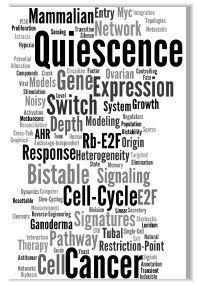-
X Wang*, K Fujimaki*, GC Mitchell*, J Kwon, K Della Croce, C Langsdorf, H Zhang, G Yao# (2017). Exit from quiescence displays a memory
of cell growth and division. Nature Communications 8:321.
-
J Kwon, NJ Everetts, X Wang, W Wang, K Della Croce, J Xing, G Yao#.
(2017) Controlling depth of cellular quiescence by an Rb-E2F network switch. Cell Reports 13: 3223-3235.
-
J Kwon, X
Wang, G Yao# (2018). Study quiescence heterogeneity by coupling single-cell measurements and computer modeling. Methods
Mol Biol. 1686:287-299.
-
K Fujimaki, G Yao# (2017). Crack the state of silence: tune the depth of cellular quiescence for cancer therapy. Mol
Cell Oncol. (In print)
-
X Wang*, J Kwon*, G Yao#. Circadian regulators affect the heterogeneity of cell cycle entry.
(In preparation)
-
MA Miller, H Zhang, G Yao#. Identifying network elements that make or break a bistable Rb-E2F cell proliferation
switch. (In preparation)
-
I Shats, M Deng, A Davidovich, C Zhang, J Kwon, D Manandhar, R Gordan, G Yao, L You (2017). Expression
level is a key determinant of E2F1-mediated cell fate. Cell Death Differ. 24: 626-637.
-
J Dai, MA Miller, NJ Everetts, X
Wang, P Li, Y Li#, JH Xu#, G Yao# (2016). Elimination of quiescent slow-cycling cells via reducing quiescence
depth by natural compounds purified from Ganoderma Lucidum. Oncotarget 21: 13770-13781.
-
C Chen, P Li, Y Li, G
Yao, JH Xu (2016). Antitumor effects and mechanisms of Ganoderma extracts and spores oil. Oncol Lett. 12: 3571-3578.
-
W Zhang*, L Wei*,
L Li*, B Yang, B Kong, G Yao#, W Zheng# (2015). Ovarian serous carcinogenesis from tubal secretory cells. Histol Histopathol. 30:
1295-1302. [PDF]
-
D Mondal, E Dougherty, A Mukhopadhyay, A Carbo, G Yao#, J Xing# (2014). Systematic reverse engineering of network
topologies: a case study of resettable bistable cellular responses. PLoS One 9:e105833. [PDF]
-
JK Srimani*, G Yao*, J Neu, Y Tanouchi, TJ Lee, S Mori, JR Nevins, L You. (2014). Linear population allocation by bistable switches in response
to transient stimulation. PLoS One 9:e105408. [PDF]
-
Y Wang, Y Wang, D Li, L Li, W Zhang, G Yao, Z Jiang, W
Zheng. (2014). IMP3 signatures of fallopian tube: a risk for pelvic serous cancers. J Hematol Oncol. 7:49. [PDF]
-
G Yao (2014). Modeling mammalian cellular quiescence. Interface Focus 4: 20130074. [PDF]
-
C Chen, J Li, G Yao#, SK Chambers,
W Zheng (2013). Tubal origin of ovarian low-grade serous carcinoma. Am J Clin Exp Obstet Gynecol. 1: 31-36. [PDF]
-
TJ Lee, G Yao, L
You. (2012). Cell cycle transition: principles of the restriction point. In Encyclopedia of Systems Biology (Dubitzky W., Wolkenhauer
O., Cho K., Yokota H., Eds.), Springer.
-
G Yao#, C Tan, M West, JR Nevins, L You. (2011). Origin of bistability underlying mammalian
cell cycle entry. Mol Systems Biol. 7:485. [PDF]
(Prior to University of Arizona)
-
J Wong, G Yao, JR Nevins, L You.
(2011). Using noisy gene expression mediated by engineered adenovirus to probe signaling dynamics in mammalian cells. Methods in Enzymology 497:
221-237. [PDF]
-
J Wong, G Yao, JR Nevins, L You. (2011). Viral-mediated noisy gene expression reveals biphasic E2f1 response to MYC.Mol Cell 41: 275-285. [PDF]
-
TJ Lee, G Yao, DC Bennett, JR Nevins, L You. (2010). Stochastic E2F activation and reconciliation
of phenomenological cell-cycle models. PLoS Biol. 8(9):e1000488. [PDF]
-
S Mori, JT Chang, ER Andrechek, N Matsumura,
T Baba, G Yao, JW Kim, M Gatza, S Murphy, JR Nevins. (2009). Anchorage-independent cell growth signature identifies tumors with metastatic
potential. Oncogene 28: 2796-2805. [PDF]
-
G Yao, TJ Lee, S Mori, JR Nevins, L You. (2008). A bistable
Rb-E2F switch underlies the restriction point. Nature Cell Biol. 10: 476-482. [PDF]
-
TJ Lee, G Yao, JR Nevins, L You.
(2008). Sensing and integration of ERK and PI3K signals by Myc. PLoS Comp Biol. 4(2):e1000013. [PDF]
-
S Mori, R Rempel,
JT Chang, G Yao, A Lagoo, JR Nevins. (2008). Utilization of pathway signatures to reveal distinct types of B-lymphoma in the Em-myc
model and human diffuse large B-cell lymphoma. Cancer Research 68: 8525-8534. [PDF]
-
AH Bild, G Yao, JT Chang, Q
Wang, A Potti, D Chasse, MB Joshi, D Harpole, JM Lancaster, A Berchuck, JA Olson Jr, JR Marks, HK Dressman, M West, JR Nevins. (2006).
Oncogenic pathway signatures in human cancers as a guide to targeted therapies. Nature 439: 353-357. [PDF]
-
M Delong, G
Yao, Q Wang, A Dobra, EP Black, JT Chang, AH Bild, M West, JR Nevins, HK Dressman. (2005). DIG - a system for gene annotation and
functional discovery. Bioinformatics 21: 2957-2959. [PDF]
-
A Dobra, C Hans, B Jones, JR Nevins, G Yao, M West. (2004).
Sparse graphical models for exploring gene expression data. Journal of Multivariate Analysis 90: 196-212. [PDF]
-
G Yao,
M Craven, N Drinkwater, CA Bradfield. (2004). Interaction networks in yeast define and enumerate the signaling steps of the vertebrate
aryl hydrocarbon receptor. PLoS Biol. 2: 355-367. [PDF]
-
G Yao, EB Harstad, CA Bradfield. (2003). The Ah receptor. In PAS
Proteins: Regulators and Sensors of Development and Physiology (S. Crews, Ed.). Kluwer Academic Publishers, Boston, MA, pp.149-182.
-
WK Chan, G Yao, YZ Gu, CA Bradfield. (1999). Cross-talk between the aryl hydrocarbon receptor and hypoxia inducible factor signaling
pathways: Demonstration of competition and compensation. J. Biol. Chem. 274: 12115-12123. [PDF]




